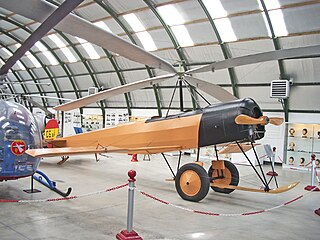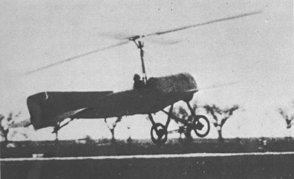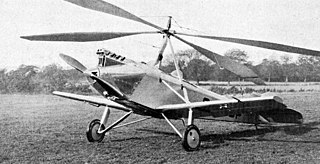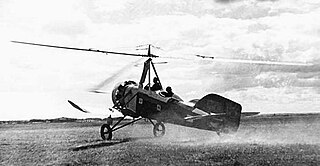
Avro was a British aircraft manufacturer. Its designs include the Avro 504, used as a trainer in the First World War, the Avro Lancaster, one of the pre-eminent bombers of the Second World War, and the delta wing Avro Vulcan, a stalwart of the Cold War.

An autogyro, also known as a gyroplane or gyrocopter, is a type of rotorcraft that uses an unpowered rotor in free autorotation to develop lift. Forward thrust is provided independently, by an engine-driven propeller. While similar to a helicopter rotor in appearance, the autogyro's rotor must have air flowing across the rotor disc to generate rotation, and the air flows upwards through the rotor disc rather than down.

Juan de la Cierva y Codorníu, 1st Count of la Cierva was a Spanish civil engineer, pilot and aeronautical engineer. His most famous accomplishment was the invention in 1920 of the first helicopter called Autogiro, a single-rotor type of aircraft that came to be called autogyro in the English language. In 1923, after four years of experimentation, De la Cierva developed the articulated rotor, which resulted in the world's first successful flight of a stable rotary-wing aircraft, with his C.4 prototype.

The Cierva C.30 was an autogyro designed by Juan de la Cierva and built under licence from the Cierva Autogiro Company by A V Roe & Co Ltd (Avro), Lioré-et-Olivier and Focke-Wulf.

The Cierva C.6 was the sixth autogyro designed by engineer Juan de la Cierva, and the first one to travel a "major" distance. Cierva, the engineer responsible for the invention of the autogyro, had spent all his funds on the research and creation of his first five prototypes. Therefore, in 1923, he turned to the Cuatro Vientos Aerodynamics Laboratory chief, Commander Emilio Herrera, who succeeded in persuading General Francisco Echagüe, the director of the Military Aviation Aeronautics Department, to take over the second stage in the research and development of Cierva's autogyros.

The Avro 552 was a British light biplane aircraft produced in the early 1920s. It was another attempt by Avro to sell a derivative of the wartime 504 to the civil market.
The Cierva Autogiro Company was a British firm established in 1926 to develop the autogyro. The company was set up to further the designs of Juan de la Cierva, a Spanish engineer and pilot, with the financial backing of James George Weir, a Scottish industrialist and aviator.
The Cierva C.1 was an experimental autogyro built by Juan de la Cierva in Spain in 1920, the forerunner of his successful series of autogyros. The C.1 was created by taking the fuselage from a Deperdussin fixed-wing aircraft and mounting two rotors shaft above it. This shaft carried two coaxial contra-rotating rotors, and atop it a fin for increased lateral stability. When tested, the C.1 refused to take off, which Cierva attributed to interference between the two sets of rotors leading to each set autorotating at a different speed. He considered the possibility of mechanically linking the rotors, but dismissed the idea on the grounds of weight and complexity, and his subsequent efforts would all feature single main rotors. Despite its failure to fly, the C.1 demonstrated the principle of autorotation in a full-sized aircraft for the first time, as it was taxied around the ground.
The Cierva C.2 was an experimental autogyro built by Juan de la Cierva in Spain in 1921-22. Following the failure of the C.1 the previous year, la Cierva started again from scratch, this time taking the fuselage from a Hanriot biplane and adding a five-bladed single rotor to it. Work was interrupted when Cierva ran out of funds, and the machine was not actually completed until 1922, after his next design, the C.3 had already been built and tested. Attempts to fly the aircraft resulted in repeated crashes, and the machine was rebuilt nine times before being finally abandoned.
The Cierva C.3 was an experimental autogyro built by Juan de la Cierva in Spain in 1921. It was based on the fuselage of a Sommer monoplane, and was actually completed and tested before that aircraft. The C.3 utilised a single, three-bladed rotor in place of the coaxial double rotor tested on the C.1. A few short hops were achieved in testing and Cierva noted a tendency for the machine to want to roll over, thus alerting him to the problem of dissymmetry of lift that he would have to overcome in order to build a successful rotary-wing aircraft. The C.3 was damaged and rebuilt four times before being abandoned without having flown, la Cierva returning to work on the C.2.

The Cierva C.4 was an experimental autogiro built by Juan de la Cierva in Spain in 1922 which early the following year became the first autogyro to fly successfully. Failures of De la Cierva's attempts to compensate for dissymmetry of lift with the C.1, C.2, and C.3 autogiros, led him to consider alternate means of enabling an autogyro to fly without rolling over. He noted that the problems experienced with his full-size aircraft were not present in the models that he had successfully flown, and considered the difference between the full-size and small-scale rotors. The rotors used on his model were made of bamboo and were thus far more flexible than the ones on his full-size aircraft. While attending an opera he realized that the flexibility eliminated the moments acting on the hub and associated instability. Trained as a civil engineer, Cierva was aware that a cantilever structure hinged to its attachment point generated no moment, and he designed a rotor the blades of which were mounted to the hub through hinges to permit their vertical oscillation.

The Cierva C.8 was an experimental autogyro built by Juan de la Cierva in England in 1926 in association with Avro. Like Cierva's earlier autogyros, the C.8s were based on existing fixed-wing aircraft fuselages – in this case, the Avro 552.

The Cierva C.12 was an experimental autogyro built by Cierva Autogiro Company in England in 1929, in association with Avro.

The Cierva C.17 was a British experimental autogyro built by Cierva Autogiro Company in England in 1928, in association with Avro. It was an attempt to build upon the successful Cierva C.8 design using the smaller, more streamlined fuselage of an Avro Avian IIIA as a starting point. The type was found to be underpowered, and when the first attempt at fitting a more powerful engine still did not result in acceptable performance, the design was abandoned.

The Cierva C.19 was a 1930s British two-seat autogyro, designed by Spanish engineer Juan de la Cierva. It was built by Avro as the Avro Type 620. It proved to be the most successful and widely produced of the early de la Cierva designs.
The Cierva C.40 was a British autogyro designed by G.B.L. Ellis, Otto Reder, and J.A.J Bennett and assembled by the British Aircraft Manufacturing Company at London Air Park, Hanworth.
The Avian 2/180 Gyroplane was a two-seat, single-engine autogyro built in Canada in the 1960s. Several prototypes were built but production was not achieved.
The Cierva C.29 was a five-seat British cabin autogyro built in 1934 as a joint venture between Westland Aircraft and Cierva. The rotor system and rotors were designed by Cierva and the fuselage by Westland. It was powered by a 600 hp (447 kW) Armstrong Siddeley Panther II engine with a two-bladed tractor propeller; the engine also drove the three-bladed rotor via a clutched shaft. The C.29 suffered from ground resonance during ground running and was not flown. It was later acquired for evaluation by the Royal Aircraft Establishment but it was unable to cure the resonance problem and the autogyro was scrapped in 1939.

The TsAGI A-4, sometimes anglicised as CAHI A-4 or ZAGI A-4, was an early Russian autogyro, influenced by Cierva designs and delivered in small numbers to the Soviet Air Force in 1934.












